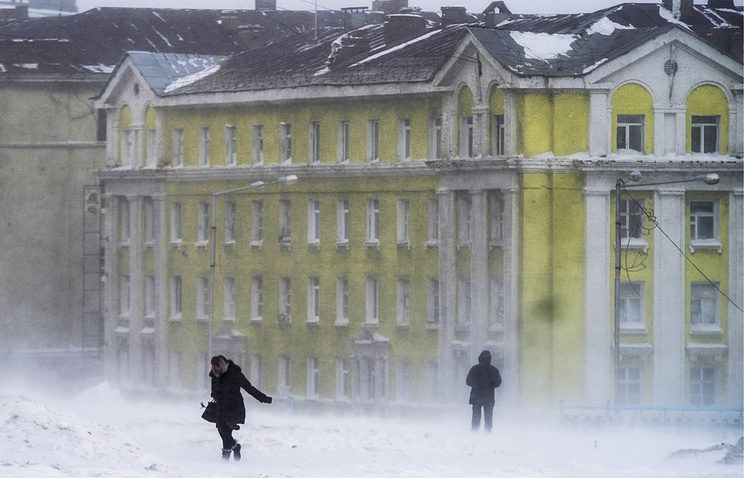Scientists have developed technologies to strengthen the soil and selected plants, which may decorate the extreme North's regions
© Kirill Kukhmar/TASSNorilsk
Permafrost causes certain problems and inconveniences in development of soil and use of its deposits, but Russian scientists and engineers adapt projects to those severe conditions. For example, specialists in St. Petersburg suggest adding pine resin into cement for construction in the Arctic, and experts in the Yamal-Nenets Autonomous District (Yamal) have found more than a hundred plants, which may decorate the extreme North's regions.
Scientists, representatives of businesses and authorities tell TASS about how the northern regions get adapted to the permafrost conditions.
Plants for the ArcticScientists have already disclaimed the opinion the Arctic land can give only scarce vegetation. Yamal's department on sciences and innovations says in 2011 local scientists presented criteria for choosing trees: they selected 322 kinds of plants from North America, mountainous East Asia and from other parts of Eurasia. Later on, they chose areas for trials.
An expert of the St. Petersburg State University Alexander Yegorov, leading the project in studies of deciduous and coniferous trees in the Arctic and sub-Arctic zones, says the project had two objectives: to add diversity to the northern cities, adapting decorative plants, and to practice effective technologies for soil revegetation after exploitation of deposit fields is over.
"Scientists recommend growing 130 kinds of plants, including trees, bushes and grass," he said. "For example, among trees there are Tibetan rowan, black, spiky and bluish spruce, cedar trees, willow, bird-cherry and some varieties of poplar."
After the experiment, the scientists will present to construction companies, local authorities and mining companies a few variants of organizing green areas.
Keeping the permafrostAnother team of scientists in St. Petersburg is working on concrete additives to allow using it in freezing temperatures. "Our scientific group has presented resins, which are used as additives for concrete," Vladimir Kulikov, Doctor of Chemistry, told TASS. "We have presented two technologies for the additives - they may be added either at plants or right at the construction site, when the additives are mixed into concrete in amounts depending on the air temperatures."
Though deep-frozen soil seems to be a good base for buildings, the biggest threat is in its melting due to the global climate change and other factors. Head of the Norilsk Center for Permafrost Studies Ali Kerimov told TASS about a complex of measures used in construction on permafrost.
"Among such technologies are fortification of soil and its cooling, as well as "treating" damaged concrete with highly effective mixtures," he said.
Vorkutaugol (a coal mining company) uses special methods in construction. Specialists say it is most important to observe the temperature regimes so that buildings' basements remain strong enough. Thus, builders install around basements certain cooling devices, which add freezing temperatures around the building in winter, so that to stabilize impact from buildings' temperatures on the environment, not allowing the soil melting; and in summer, they provide freezing temperatures to guarantee the soil's stability.
How to build roads and mines in the ArcticThe Tyumen Industrial University has studies into impacts from industrial and road infrastructures on permafrost soils. The technical and technological solutions are effective in buildings' safety and in road coating's durability, the university said.
Such studies are of high demand: authorities in the Nenets Autonomous District told TASS during construction of the road between Naryan-Mar and Usinsk the road surface sank because of the frozen soil. "During the winter periods of construction, the temperatures were crossing the zero level a few times, which affected the permafrost's stability, and thus we had to made additional job," the authority said, adding the construction cost had grown.
Miners also have to undertake additional measures. Among them, is the mentioned-earlier Vorkutaugol, which develops the Yunyaginskoye coal deposit in the permafrost conditions. This is the first enterprise in the world, which decided to have an open pit in the permafrost.
The company told TASS the biggest problem in mining coal in the open pit is in using the equipment, which is adapted to working in extremely low temperatures and stormy winds. "The vehicles and equipment should be made of special steels and alloys, as regular steels and alloys in the temperatures around minus 50 degrees are fragile and may fall apart," the company said. "Cabins should be adjusted accordingly to be able to provide optimal climate conditions."
Legislation for the permafrostThe issue of construction safety in the Arctic and in the permafrost areas has reached the state level. Under the state program on development of the Arctic, the Ministry of Construction is due to work on recommendations related to geo-technical monitoring of major cities in the Murmansk region, Karelia, Arkhangelsk region, the Nenets Autonomous District, the Komi republic, the Yamal-Nenets Autonomous District, the Krasnoyarsk Territory, Yakutia, and the Chukotka Autonomous District.
The recommendations, and new regulations for construction in the Arctic, are due to be ready by 2020. Authorities of the northern regions say it necessary to have a legal systematic base also for studies and use of the permafrost.
"The problem of permafrost is growing along with the industrial development of the Far East and Arctic," speaker of Yakutia's parliament Alexander Zhirkov said. "It is a huge territory, of about ten million square kilometers, which takes 65% of the Russian Federation's territory, and thus it is most important to have the legal regulation of using and preserving the permafrost - to support the fragile environmental balance.".
I learned this doing service work for a blood bank. and yes, it is true...
strange things start happening at around those temps... things do get brittle.. and it is tough to keep the drain lines open. mining coal at -50 eh?